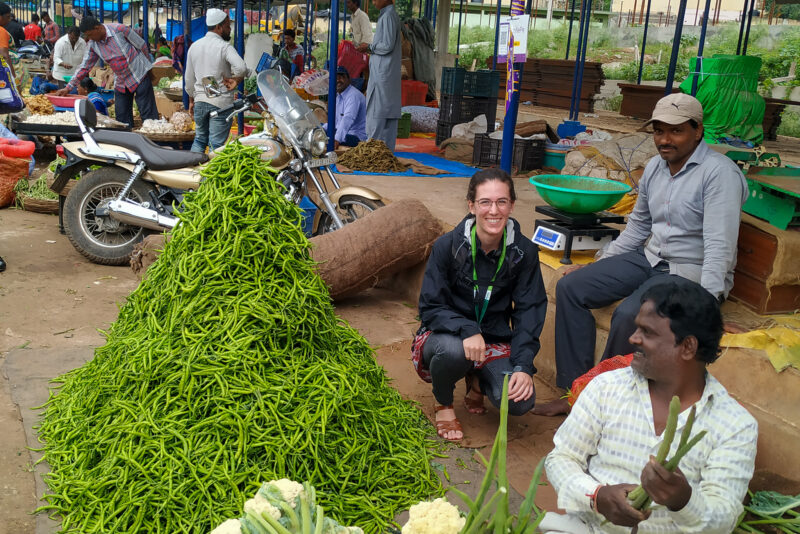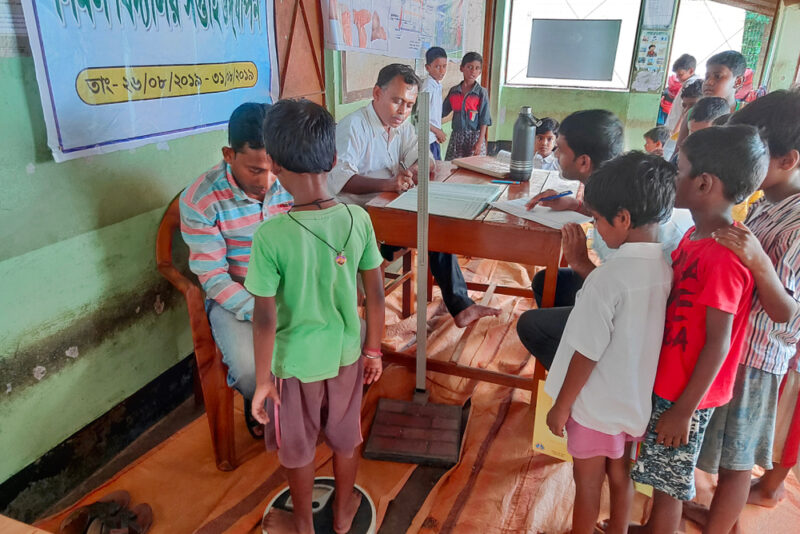Farmer Research Networks Enable More Effective Local Solutions

Researchers across the world devise innovative solutions to issues faced by farmers in developing countries, but the effectiveness of those solutions depends on how well they align with the specific needs of the local communities where they are implemented. In a new study published in the journal Agricultural Systems, Tata-Cornell Institute for Agriculture and Nutrition (TCI) alumnus Anthony Wenndt demonstrates that farmer research networks—comprising groups of community members and researchers—can help tailor interventions to local situations and enable local insights to feed back into global systems innovations.
Coauthored by TCI Director Prabhu Pingali, Faculty Fellow Rebecca Nelson, and Hari Kishan Sudini, a scientist at TCI partner organization, the International Crops Research Institute for Semi-Arid Tropics (ICRISAT), Wenndt’s study details their experience creating a farmer research network to explore food safety in Unnao, India.
Farmer research networks are an expansion of the concept of community-based participatory research, whereby researchers and community members work together to formulate solutions to local issues. Often, under such an arrangement, information flows down a one-way street from farmers to researchers. Farmer research networks allow information to flow both ways, driving knowledge feedback loops that enable innovation at both ends of the local-global spectrum. This approach allows farmers to use their local expertise to discover, evaluate, and adapt intervention options that are consistent with local priorities and the farmers’ own visions of success.
“The farmer research network approach offers a complement to formal regulatory infrastructure that intentionally draws community members into the very process of diagnosing and addressing risk factors in ways that are aligned with their own needs,” Wenndt said.
“Farmers have a sincere interest in improving their own livelihoods but may not know how to access the information necessary to make an informed choice for their context,” Wenndt said. “The role of the researcher, therefore, is to curate a range of plausible evidence-based solutions that can be proposed to farmers, who in turn can select, reject, or refine those options in accordance with their needs.”
While farmer research networks are not a novel concept, their use in food safety research is new. Hazards like mycotoxins can often endanger food systems because they are not easily detectable by the naked eye. This is especially true in under-resourced rural areas, which often lack the regulatory mechanisms necessary to ensure food safety. “The farmer research network approach offers a complement to formal regulatory infrastructure that intentionally draws community members into the very process of diagnosing and addressing risk factors in ways that are aligned with their own needs,” Wenndt said.
In Unnao, Wenndt and his collaborators organized a farmer research network across six different villages to diagnose local food safety needs and develop and implement solutions. They found that the approach was an effective strategy for building collective identity around shared food safety concerns and successfully facilitated collaboration between the researchers and the farmer groups.
The network decided to focus its efforts on the spoilage and contamination of stored grains due to the local prevalence of pest infestation and spoilage molds. After deliberating on potential interventions to address the issue, the farmer research network decided to conduct a trial using hermetically sealed bags to safely store grains. The trial was co-designed by Wenndt’s research team in equal partnership with the farmer groups, with the farmers playing key roles in appraising intervention options and adapting them to their local contexts.
In the end, 99 percent of participating farmers reported positive results using the hermetically sealed bags distributed for the project.
“That amount of agency in intervention design is so rarely afforded to end-users, and I think that is one of the most valuable things about the farmer research network approach,” Wenndt said. “The intervention was not only the hermetic sacks, but the entire process surrounding their selection and implementation, resulting in improvements not only to the quality of food in these villages, but to the farmers’ collective ability to diagnose and solve food safety concerns.”
In the end, 99 percent of participating farmers reported positive results using the hermetically sealed bags distributed for the project. While Wenndt and his coauthors found that farmers were reluctant to purchase bags due to their high price relative to more conventional storage options, 83 percent of participants continued to use them after the initial trial, indicating overall satisfaction with the technology.
“In the beginning, we had no information on how to collect and keep the grains. We used to store the grains according to our wishes, and many times our grain was wasted,” said one participant in the study. “But I have now used the hermetic sacks and kept them for a year. When I opened them, I found the grain to be clean and safe.”
Before they began their efforts to improve food safety, members of the network engaged in activities designed to build trust and a sense of collective identity among them. The researchers also conducted leadership training sessions for the network members and elected officers in each of the villages. Wenndt says this step was crucial because there was low overall awareness and organization around the concept of food safety in the area.
“In lieu of any existing organizational frameworks in the local communities, it became a central focus to dig deeply into the shared identities and priorities around food and farming,” Wenndt said. “These efforts enabled us to forge relationships of trust across social and cultural barriers, which ultimately was a key determinant of the success of the network.”





